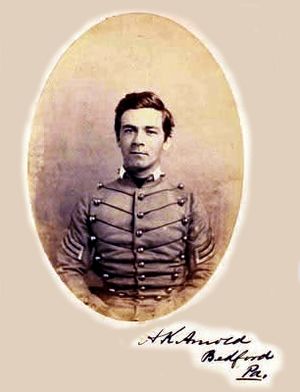Abraham Arnold facts for kids
Quick facts for kids
Abraham Kerns Arnold
|
|
|---|---|

Abraham Arnold
|
|
| Born | March 24, 1837 Bedford, Pennsylvania |
| Died | November 3, 1901 (aged 64) Cold Spring-On-Hudson, New York |
| Place of burial |
Cemetery of Saint Philip's Church
Garrison, New York |
| Allegiance | United States of America Union |
| Service/ |
United States Army Union Army |
| Years of service | 1859–1901 |
| Rank | |
| Unit | 5th U.S. Cavalry |
| Commands held | 1st U.S. Cavalry 8th U.S. Cavalry |
| Battles/wars | American Civil War
|
| Awards | Medal of Honor |
Abraham Kerns Arnold (born March 24, 1837 – died November 3, 1901) was a brave U.S. Cavalry officer. He served during the American Civil War. As a captain in the 5th U.S. Cavalry, he received the Medal of Honor. This special award was given for his actions on May 10, 1864. At Davenport Bridge, Virginia, he led a "gallant charge" against a stronger enemy force. He saved his troops from a very dangerous situation.
Abraham Arnold was also the father of Colonel Percy Weir Arnold. Percy followed in his father's footsteps, serving as a cavalry officer. He fought in the Spanish–American War, the Philippine–American War, and the First World War.
Contents
Abraham Arnold's Early Life
Abraham Arnold was born in Bedford, Pennsylvania. He attended the West Point military school. He graduated in 1859. After graduating, he became a temporary Second Lieutenant in the 2nd Cavalry Regiment. This unit later became the 5th U.S. Cavalry.
A Life in the Military
Before the Civil War, Arnold fought in campaigns against the Comanche people. He was stationed at Fort Inge.
Serving in the Civil War
Abraham Arnold had a distinguished service record during the American Civil War. In April 1861, he was promoted to first lieutenant. He served as an adjutant, helping the commander of the 5th Cavalry Regiment.
He was recognized for his "gallant and meritorious services" at the Gaines' Mill and Todds Tavern. He earned temporary promotions to captain and major after these battles.
His most famous act was at the Battle of Davenport Bridge. He led his cavalry regiment in a charge against a larger Confederate force. He did this to rescue his men and prevent them from being captured. For this brave action, he received the Medal of Honor.
After the Civil War
In June 1869, Arnold was promoted to a full major in the 6th U.S. Cavalry. In the late 1870s, he led operations against the Apache people in Arizona. He even went into Mexico to track down Apache groups.
He also took part in the Battle of Cibecue Creek on August 30, 1881. This was while he was helping General Orlando B. Willcox. In 1886, as a lieutenant colonel, he joined an expedition against the Crows in the North Plains.
Over the next twelve years, he held many important command roles. From 1895 to 1898, he commanded the Cavalry and Light Artillery School. He was promoted to colonel in 1891.
The Spanish–American War
During the Spanish–American War, he became a temporary brigadier general. He led the 2nd U.S. Division of the 7th Army Corps in Cuba. He served there from January 16, 1898, until April 1, 1899.
Later Life and Legacy
Abraham Arnold retired from the military on March 25, 1901. He passed away several months later, on November 3, 1901. He died in Cold Spring-On-Hudson, New York. His grave is located in the Cemetery of Saint Philip's Church in Garrison, New York.

